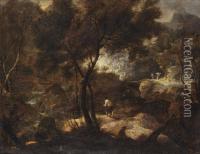Josef Franz Faistenberger Paintings
Josef Franz Faistenberger was an Austrian artist known for his work in the Baroque period, born in 1692 and deceased in 1750. Although not as widely recognized as some of his contemporaries, Faistenberger contributed to the rich tapestry of Baroque art that flourished in Austria and Southern Germany during the early 18th century.
Faistenberger received his artistic training likely in Austria, although specific details about his early education and influences remain somewhat obscure. He was active during a time when European art was characterized by dramatic expression, grandeur, and movement, which were all elements of the Baroque style that emerged in response to the Protestant Reformation and the Counter-Reformation.
The artist's work included religious themes, which were prevalent in Baroque art, as the Catholic Church was a major patron during this period. Faistenberger's pieces would have been used to inspire devotion and convey the power and glory of the Church. His oeuvre may have included altarpieces, frescoes, and other church decorations, although surviving works attributed to him are scarce.
There is limited information available about Faistenberger's career and personal life, and much of what might have been known could have been lost over time. The lack of records could be attributed to the turbulent history of the region, the overshadowing fame of more prominent artists of the era, or the possible niche nature of his work. Despite these challenges, his inclusion in the historical record signifies that he held a place within the artistic community of his time.
Josef Franz Faistenberger passed away in 1750. While his legacy may not compare with that of giants like Rembrandt or Caravaggio, he remains a part of the narrative of Baroque art history. His contributions, as with many artists of the period, would have influenced the visual culture of his region and provided a stepping stone in the evolution of artistic styles and themes.
